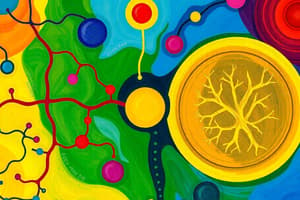Podcast
Questions and Answers
Which metabolic pathway is responsible for breaking down glucose into pyruvate, generating ATP and NADH?
Which metabolic pathway is responsible for breaking down glucose into pyruvate, generating ATP and NADH?
- Gluconeogenesis
- Citric Acid Cycle (Krebs Cycle)
- Glycolysis (correct)
- Oxidative Phosphorylation
In what cellular location does the Citric Acid Cycle (Krebs Cycle) take place?
In what cellular location does the Citric Acid Cycle (Krebs Cycle) take place?
- Endoplasmic Reticulum
- Mitochondrial Matrix (correct)
- Cytoplasm
- Inner Mitochondrial Membrane
Which process involves the production of ATP using energy derived from the electron transport chain and a proton gradient?
Which process involves the production of ATP using energy derived from the electron transport chain and a proton gradient?
- Oxidative Phosphorylation (correct)
- Gluconeogenesis
- Beta-oxidation
- Glycolysis
During periods of fasting or starvation, which metabolic pathway is activated to maintain blood glucose levels?
During periods of fasting or starvation, which metabolic pathway is activated to maintain blood glucose levels?
Where does beta-oxidation, the process of breaking down fatty acids into acetyl-CoA, NADH, and FADH2, occur within the cell?
Where does beta-oxidation, the process of breaking down fatty acids into acetyl-CoA, NADH, and FADH2, occur within the cell?
What is the primary purpose of the urea cycle in amino acid metabolism?
What is the primary purpose of the urea cycle in amino acid metabolism?
Which regulatory mechanism involves the end product of a metabolic pathway inhibiting an enzyme early in the pathway?
Which regulatory mechanism involves the end product of a metabolic pathway inhibiting an enzyme early in the pathway?
Which of the following best describes the role of acetyl-CoA in metabolic pathways?
Which of the following best describes the role of acetyl-CoA in metabolic pathways?
How do anabolic pathways differ from catabolic pathways in terms of energy requirements?
How do anabolic pathways differ from catabolic pathways in terms of energy requirements?
What is the ultimate fate of pyruvate under anaerobic conditions, such as during intense exercise in muscle cells?
What is the ultimate fate of pyruvate under anaerobic conditions, such as during intense exercise in muscle cells?
Flashcards
Biomolecules
Biomolecules
Fundamental building blocks of life including carbohydrates, lipids, proteins and nucleic acids.
Metabolism
Metabolism
The sum of all chemical reactions that occur within a cell or organism, essential for life processes.
Enzymes
Enzymes
Biological catalysts that speed up biochemical reactions by lowering activation energy.
Monosaccharides
Monosaccharides
Signup and view all the flashcards
Disaccharides
Disaccharides
Signup and view all the flashcards
Polysaccharides
Polysaccharides
Signup and view all the flashcards
Phospholipids
Phospholipids
Signup and view all the flashcards
Nucleic Acids
Nucleic Acids
Signup and view all the flashcards
Metabolic Pathways
Metabolic Pathways
Signup and view all the flashcards
Glycolysis
Glycolysis
Signup and view all the flashcards
Study Notes
The provided text duplicates the existing notes, so no updates were made.
Studying That Suits You
Use AI to generate personalized quizzes and flashcards to suit your learning preferences.




